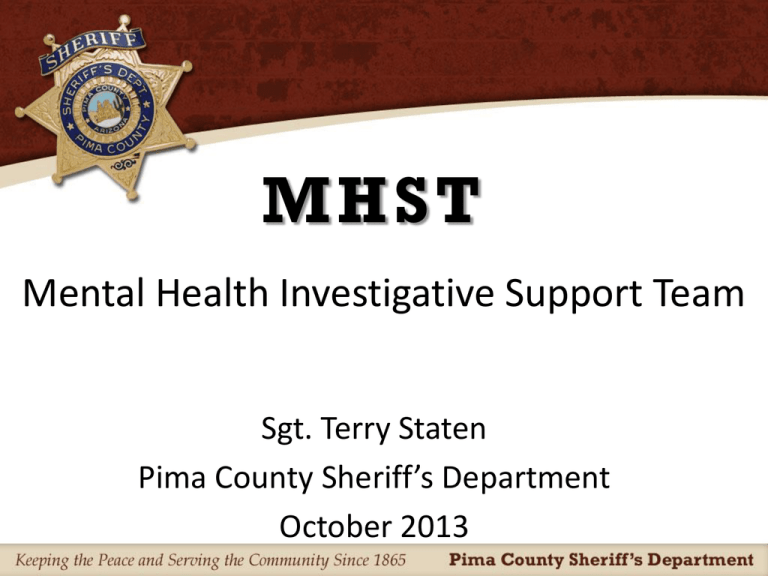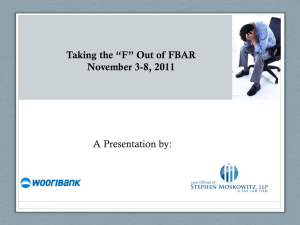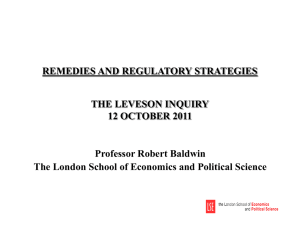What Are We Doing Different Now
advertisement

MHST Mental Health Investigative Support Team Sgt. Terry Staten Pima County Sheriff’s Department October 2013 What Are We Doing Different Now Mental Health Support Team (MHST) • The Sheriff’s Department recognized the need to take a different approach to mental health issues related to law enforcement • The wave of mass shootings and the increased mental health related calls served as a catalysts for taking a fresh look Overview • Background/History – Started December, 2012 • • • • • The Process Before MHST Significant Events Philosophy Shift Development and Approach of MHST Where We Are Now The Old Way • Civil Division Deputies – Serving Mental Health Orders • Evaluation orders • Treatment orders – Service rate about 30% • Patrol Deputies – Service rate even lower SIGNIFICANT EVENTS • October 28, 2002 – Three nursing professors killed at the University of Arizona Medical school – Multi-agency response to an active shooter SIGNIFICANT EVENTS • Shooter – Robert Flores • Previous contacts – Mental health – Law enforcement SIGNIFICANT EVENTS • Dep. Timothy Graham, PCSO • End of Watch - August 10, 2005 • Responded to a convenience store where Aaron Swyers with history of mental health issues was in crisis SIGNIFICANT EVENTS • Tucson Police Officer Erik Hite • End of Watch – June 2, 2008 • Responded to “officers need assistance” call • Deputy wounded SIGNIFICANT EVENTS • Shooter – David Delich • Previous contacts – Mental health – Law enforcement SIGNIFICANT EVENTS • January 8, 2011 – Mass shooting at grocery store parking lot event – 6 killed, 19 wounded, including Congresswoman Gabrielle Giffords SIGNIFICANT EVENTS • Shooter – Jared Loughner • Previous contacts – Mental health – Law enforcement Philosophy Shift • Has to be a better way to approach problem • Need to – Decrease risk to officers/deputies – Decrease risk to community – Decrease waste of taxpayer dollars – BREAK THE CYCLE Philosophy Shift • Goals – Improve officer safety – Improve community safety • Identify and intervene sooner when possible – Improve efficiency & save taxpayer dollars – Reduce liability to the department • Fewer “hands on” situations – BREAK THE CYCLE Philosophy Shift • To help meet goals – Need changes in the legal system • Courts’ expectation to treat individuals with mental illness differently – Changes in community resources • Active Crisis Intervention Training (CIT) program collaboration • Collaboration with mental health system • Collaboration with other law enforcement agencies The Old Approach • Patrol deputies would look for the quickest, easiest solution to a situation with a mental health nexus – Often resulting in arrest and incarceration – As a result, the Pima County Jail is now the largest behavioral health facility in southern Arizona – The problems continue The Costs • Repeated responses to same mental health related calls • Frequent consumers of services • Frustration with the system • People fall through the cracks in the system The Costs-continued • Man hours spent by departments on mental health issues are a drain on resources 1 repeat consumer 2080 hours in a year 1 new officer Where We Fail • Many people suffering from mental health issues fall between the cracks of the system • They always become the burden of law enforcement Law Enforcement MHST Courts Behavior al Health Development of MHST • Personnel – 7 full-time personnel • 3 uniform deputies • 2 detectives • 1 sergeant • 1 civilian support specialist – Developing into a regional resource The New Approach • 100 % service rate on mental health orders • Mental health facilities and providers communicating with law enforcement • One central location for patrol to go to for answers to problems • Law enforcement talking to law enforcement How It Works • MHST is responsible for the service of all mental health related court orders • All field calls where the core issue is a mental health crisis AND a threat to public safety is identified are tagged for follow up by MSHT detectives Triaging The Calls • Calls where there is not a threat to public safety (danger to self) are handled as they always have been-referred to the appropriate mental health provider – Voluntary committal – Involuntary committal – Referral to various providers Triaging The Calls • Calls for service where there is a criminal component, and the person is a threat to others (public safety) – Routed to the MHST Unit for follow up – A full criminal/mental health investigation is conducted where appropriate – A unique 2-pronged process is initiated The MHST Investigation Long term care, medication Adjudication or mental health diversion Presentation to evaluating provider Presentation to Prosecutors Start of criminal investigation Criminal Investigation Start of the mental health investigation Initial Call Mental Health Investigation Prioritizing Solutions Medical- Medical issues that are critical must be addressed first Criminal – Criminal charges will take priority over an immediate mental health solution Mental Health – Mental health solutions will generally be the third priority and can be begin along with both the medical and criminal processes MHST Focus MHST Partnership with Providers • MHST will focus on those cases with a criminal nexus – Allowing for a law enforcement action & ownership – No HIPAA issues for law enforcement • MHST will not focus on danger to self cases – No role for law enforcement beyond immediate care and referral SUCCESSES • John – History of mental illness – History of assaulting dad and destroying his house – History of not staying on his medication program – Now staying on his program – Dad now helping his son stay on the program – No new law enforcement interactions SUCCESSES • Brandon – Texted girl friend and threatened to shoot up school and “do it better than Columbine” – Arrested and evaluation ordered – Failed to continue counseling and violated restraining order – Determined counselor was not a right fit – Brandon back in counseling with new counselor Questions








